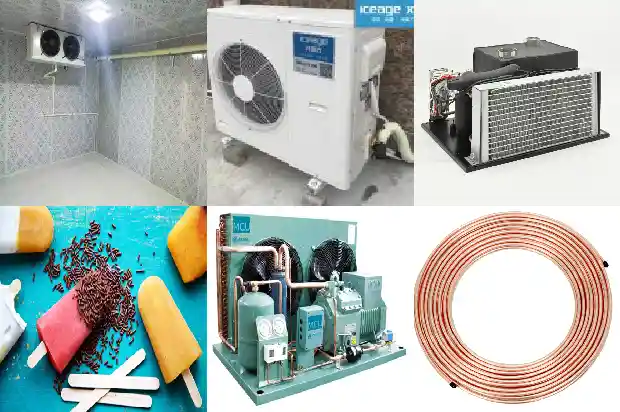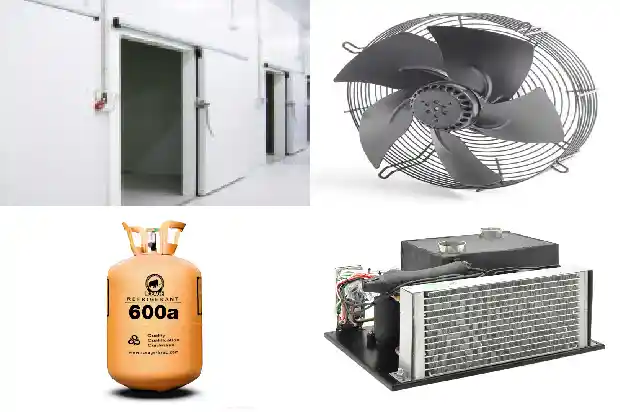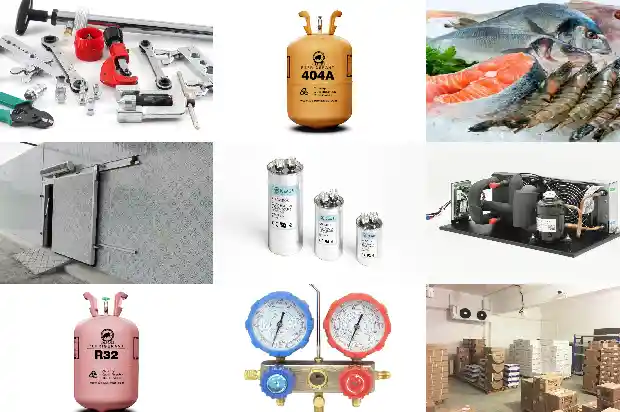Comprehensive Guide to the Operation and Maintenance of Cold Storage
2025-03-09
Cold storage: It is a special low-temperature warehouse established by artificial refrigeration methods. Its function is to carry out freezing processing and storage of perishable items, or to cool down certain process equipment and the environment.
It can be roughly divided into the following types: vegetable freshness preservation cold storage, frozen goods refrigeration cold storage, cooling cold storage, freezing cold storage, ice storage, process cold storage, etc.
Cold storage can be classified by structural form into: civil construction type and assembled type.
Application of civil construction cold storage: Due to its good thermal insulation effect and relatively small influence from the outside, it is widely used in some large production and wholesale bases of fruits and vegetables, as well as some meat and poultry processing plants.
Application of assembled cold storage: Assembled cold storage features a simple structure, convenient installation, a short construction period, light weight, high strength, and beautiful appearance. It is now more and more widely adopted in the commercial field, especially in hotels, restaurants, vegetable markets, and the commercial food circulation field.
It can be roughly divided into the following types: vegetable freshness preservation cold storage, frozen goods refrigeration cold storage, cooling cold storage, freezing cold storage, ice storage, process cold storage, etc.
Cold storage can be classified by structural form into: civil construction type and assembled type.
Application of civil construction cold storage: Due to its good thermal insulation effect and relatively small influence from the outside, it is widely used in some large production and wholesale bases of fruits and vegetables, as well as some meat and poultry processing plants.
Application of assembled cold storage: Assembled cold storage features a simple structure, convenient installation, a short construction period, light weight, high strength, and beautiful appearance. It is now more and more widely adopted in the commercial field, especially in hotels, restaurants, vegetable markets, and the commercial food circulation field.
- Compressor:
Compression refrigeration unit (air-cooled unit)
Appearance of air-cooled unit air conditioner
Water-cooled unit
The plastic cap of the semi-hermetic refrigeration compressor should not be lost.
In case of an oil pressure alarm fault, the oil pressure button should be reset after the fault is eliminated.
Fully enclosed scroll compressor - Condenser:
Condenser: It transfers the heat of the high-temperature and high-pressure refrigerant vapor from the compressor to the surrounding medium - water or air, and cools it into a low-temperature and high-pressure liquid. It is a necessary device for outputting heat outside the system.
Types of condensers: Air-cooled type (referred to as air-cooled or air-blast type for short); Water-cooled type (referred to as water-cooled type for short); Evaporative type.
Water-cooled condenser:
Air-cooled condenser: - Receiver:
A container for storing and supplying high-pressure liquid refrigerant. It stores the liquid refrigerant from the condenser and regulates and stabilizes the circulation volume of the refrigerant to adapt to the changes in working conditions.
It is usually installed behind the condenser (air-cooled unit). The water-cooled unit with a liquid storage function generally does not need to install a receiver. - Drying filter:
It removes moisture and dirt in the system to prevent the system from generating ice blockage or dirt blockage. It is a purification device for the refrigeration system. - Pressure controller:
It controls the high and low pressures. When the exhaust pressure is too high or the suction pressure is too low, the controller will immediately act to cut off the pressure control circuit, making the compressor stop. - Pressure gauge:
Pressure gauge: It displays the high-pressure and low-pressure values.
Range of the high-pressure gauge (-0.1~3.8 MPa); Range of the low-pressure gauge (-0.1~1.8 MPa).
MPa; kgf/cm2; Psi;
1MPa≈10 kgf/cm2 = 145Psi. - Solenoid valve and sight glass:
Function of the solenoid valve: It controls the flow rate of the refrigerant to cut off or open the liquid supply to the system.
Function of the sight glass: To check the condition of the refrigerant in the liquid pipeline and the water content of the refrigerant. - Thermostatic expansion valve:
The thermostatic expansion valve controls the opening degree of the expansion valve through the superheat degree of the gaseous refrigerant at the outlet of the evaporator. According to different balancing methods, the thermostatic expansion valve can be divided into two types: internal balance type and external balance type. - Air cooler:
It is a heat exchanger where the refrigerant absorbs heat at a low temperature. In the evaporator, the refrigerant liquid coming from the expansion valve boils at a relatively low temperature, turns into gas, and absorbs the heat of the cooled object or medium to achieve the purpose of cooling and refrigeration.
According to the air convection mode, it is divided into: air cooler and coil. - Electrical components:
Air switch: The main switch of the refrigeration equipment, which controls the start and stop of the system and trips instantly to protect when the system current is too large.
AC contactor: It controls the start and stop of the compressor and the fan, and the defrosting of the heating wire inside the fan.
Thermal overload relay: A protection component for excessive current.
Note: Regarding the position of the warehouse temperature probe, the goods should not press on the warehouse temperature probe. - Principle of the refrigeration system:
- After starting the refrigeration equipment, the compressor works and discharges high-temperature and high-pressure refrigerant gas; (The temperature of the exhaust pipe can be as high as 120 degrees)
- Through the air-cooled condenser (or water-cooled condenser), the heat absorbed by the refrigerant in the evaporator is taken away by air (or water), and it is cooled and condensed into a subcooled liquid at normal temperature and high pressure;
- It flows through the receiver, filter, sight glass, and solenoid valve;
- After throttling and reducing pressure through the thermostatic expansion valve, it becomes a low-pressure and low-temperature refrigerant liquid and then flows into the evaporator (air cooler or coil);
- The refrigerant evaporates in the evaporator and absorbs the heat of the goods, thus achieving the purpose of cooling the interior;
- The refrigerant after absorbing heat through evaporation becomes a low-temperature and low-pressure gas again, returns to the compressor, is compressed again, and then discharged. This cycle repeats, and finally, the temperature in the warehouse is reduced to the specified temperature within the specified time.
- Defrosting of the cold storage:
Notes: - Since the goods stored in the cold storage are different, the humidity in the warehouse is different, and the amount of frost formed on the air cooler is also different. Therefore, different defrosting values should be set according to the different goods stored.
The defrosting cycle and defrosting time set by the engineering equipment commissioning personnel during commissioning are conventional set values.
- The cold storage management personnel should often observe the frosting and defrosting conditions of the air cooler, and adjust the defrosting cycle and defrosting time according to the defrosting situation of the air cooler, so that the frost can be completely removed without causing the warehouse temperature to rise too much, in order to achieve the goal of power saving.
- After the equipment enters the automatic defrosting program, the power supply cannot be turned off at this time, otherwise the defrosting program will not be able to proceed.
- Regularly check the smoothness of the defrosting water pipe to ensure that the defrosting water is transferred out in a timely manner.

- If there is too much frost formed in the fan coil, forced defrosting can be carried out. Manual forced defrosting can be implemented for defrosting.
- Common faults:
Related Articles
- Screw Compressor Units: Principles, Design and Selection - Essential Guide for Refrigeration Beginners
- Advanced Guide! Design and Installation of Refrigeration System Pipelines
- What Factors Affect the Abnormal Operation of the Control Valve in the Cold Storage?
- Operation and Maintenance Process of Cooling Towers
- Analysis of the Composition, Control and Operation Process of Cold Storage System
- Reasons for Compressor Oil Deterioration and Oil - adding Operations
- Operation and Precautions of Frozen and Refrigerated Auxiliary Equipment
- Oil Cooling Methods and Oil - changing Operation Procedures for Screw Compressors
- Refrigeration System: Copper Pipe Welding and Flushing Operations
- Essential for Maintenance! Parameters and Phenomena of Normal Operation of Refrigeration and Heating Systems
- What is the Correct Operation Method of the Distribution Box during Cold Storage Installation?
- Operation of Screw - type Water - cooled Chiller Units
- Considerations in Selecting Packaged Air Conditioners and Their Heat Recovery Operations
- Common Malfunctions in the Operation of Cold Storage
- What Are the Three Essential Conditions for the Safe Operation of the Refrigeration System?
- Common Issues in Chiller Operation and Solutions
- Operations and Precautions for Multi - split Air Conditioners: Blowing Debris, Air Tightness, Vacuum Drying, and Refrigerant Charging
- What Should Be Done When the Condenser Fan Doesn't Rotate During Operation?
